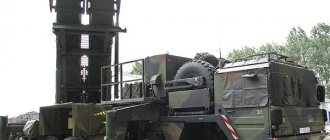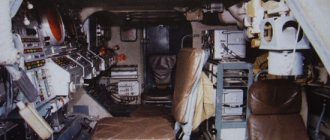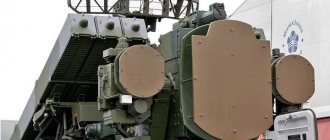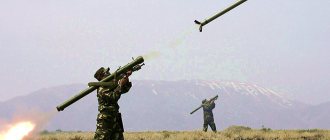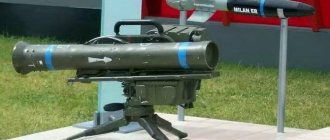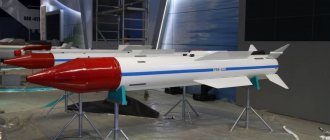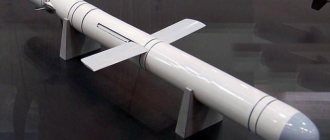Long-range anti-aircraft missile system S-200
In the mid-1950s. In the context of the rapid development of supersonic aviation and the emergence of thermonuclear weapons, the task of creating a transportable long-range anti-aircraft missile system capable of intercepting high-speed high-altitude targets has acquired particular relevance. The S-75 mobile system, adopted for service in 1957, in its first modifications had a range of only about 30 km, so the formation of defense lines on the likely flight paths of a potential enemy’s aircraft to the most populated and industrialized areas of the USSR using these complexes became into an extremely expensive undertaking. It would be especially difficult to create such lines in the most dangerous northern direction, which was located on the shortest approach route for American strategic bombers.
The northern regions, even the European part of our country, were distinguished by a sparse network of roads, low density of settlements, separated by vast areas of almost impassable forests and swamps. A new mobile anti-aircraft missile system was required. With a greater range and height of target interception.
In accordance with Government Decrees of March 19, 1956 and May 8, 1957 No. 501-250, many organizations and enterprises of the country were involved in the development of a long-range anti-aircraft missile system. Leading organizations were identified for the system as a whole and for the ground-based radio equipment of the fire complex - KB-1 GKRE, and for the anti-aircraft guided missile, which at first had the designation B-200 - OKB-2 GKAT. The general designers of the system as a whole and the missile were appointed, respectively, A.A. Raspletin and P.D. Grushin.
The preliminary design for the B-860 (5V21) rocket was released by OKB-2 at the end of December 1959. Particular attention during the design was paid to taking special measures to protect the rocket’s structural elements from aerodynamic heating that occurs during a long (more than a minute) flight with hypersonic speed. For this purpose, the areas of the rocket body that are most heated during flight were covered with thermal protection.
The design of the B-860 used mainly non-scarce materials. To give the structural elements the required shapes and sizes, the most highly productive production processes were used - hot and cold stamping, large-sized thin-walled casting of products from magnesium alloys, precision casting, various types of welding. A liquid-propellant rocket engine with a turbopump system for supplying fuel components to a single-action combustion chamber (without restarting) operated on components that had already become traditional for domestic missile defense systems. Nitric acid with the addition of nitrogen tetroxide was used as an oxidizer, and triethylamine xylidine (TG-02, “tonka”) was used as fuel. The temperature of the gases in the combustion chamber reached 2500-3000 degrees C. The engine was made according to an “open” design - the combustion products of the gas generator, which ensures the operation of the turbopump unit, were released through an elongated pipe into the atmosphere. The initial start of the turbopump unit was provided by a pyrostarter. For the B-860, the development of starting engines using mixed fuel was assigned. These works were carried out in relation to the TFA-70 formulation, then TFA-53KD.
The indicators for the range of destruction of targets looked noticeably more modest than the characteristics of the American Nike-Hercules complex or the 400 missile defense system for Dali that had already entered service. But just a few months later, by the decision of the Commission on Military-Industrial Issues of September 12, 1960. No. 136, the developers were instructed to increase the B-860’s engagement range of supersonic targets with Il-28 EPR to 110-120 km, and subsonic targets to 160-180 km. using the “passive” section of the rocket’s inertial movement after the completion of its propulsion engine
Anti-aircraft guided missile 5V21
Based on the results of consideration of the preliminary design, a system combining a fire complex, missiles and a technical position was adopted for further design. In turn, the fire complex included: • a command post (CP), which controls the combat operations of the fire complex; • situational awareness radar (SAR); • digital computer; • up to five firing channels.
The command post was connected to a situation clarification radar, which was used to determine the exact coordinates of the target with rough target designation from external means, and a single digital machine for the complex. The firing channel of the fire complex included a target illumination radar (RTI), a launch position with six launchers, power supply equipment, and auxiliary equipment. The configuration of the channel made it possible to fire sequentially at three air targets without reloading the launchers, ensuring simultaneous homing of two missiles at each target.
ROC SAM S-200
The target illumination radar (RTI) of the 4.5-cm range included an antenna post and a control cabin and could operate in coherent continuous radiation mode, which achieved a narrow spectrum of the probing signal, ensured high noise immunity and the longest target detection range. At the same time, simplicity of execution and reliability of the seeker were achieved. However, in this mode, the range to the target was not determined, which is necessary to determine the moment of missile launch, as well as to construct the optimal trajectory for pointing the missile at the target. Therefore, the ROC could also implement a phase-code modulation mode, which somewhat expands the signal spectrum, but ensures the range to the target.
The probe signal from the target illumination radar reflected from the target was received by the homing head and a semi-active radio fuse coupled to the seeker, operating on the same echo signal reflected from the target as the seeker. The missile's onboard radio equipment also included a control transponder. The target illumination radar operated in the mode of continuous emission of a probing signal in two main operating modes: monochromatic radiation (MCI) and phase code modulation (PCM).
In the monochromatic radiation mode, the air target was tracked in elevation, azimuth and speed. The range could be entered manually based on target designation from the command post or attached radar equipment, after which the approximate altitude of the target was determined using the elevation angle. Capture of air targets in monochromatic radiation mode was possible at a range of up to 400-410 km, and the transition to automatic target tracking with a missile homing head was carried out at a range of 290-300 km.
To control the missile along the entire flight path, a “rocket-RPC” communication line was used to the target with an on-board low-power transmitter on the rocket and a simple receiver with a wide-angle antenna on the RPC. If the missile defense system failed or malfunctioned, the line stopped working. The S-200 air defense system for the first time featured a digital computer, the “Plamya” digital computer, which was tasked with exchanging command and coordinate information with various command posts before solving the launch problem.
The anti-aircraft guided missile of the S-200 system is two-stage, made according to a normal aerodynamic design, with four triangular wings of high aspect ratio. The first stage consists of four solid rocket boosters mounted on the sustainer stage between the wings. The sustainer stage is equipped with a 5D67 liquid-propellant two-component rocket engine with a pump system for supplying fuel components to the engine. Structurally, the sustainer stage consists of a number of compartments in which a semi-active radar homing head, on-board equipment units, a high-explosive fragmentation warhead with a safety-actuating mechanism, tanks with fuel components, a liquid-propellant rocket engine, and rocket control units are located. The rocket launch is inclined, with a constant elevation angle, from a launcher aimed in azimuth. The warhead weighs about 200kg. high-explosive fragmentation with ready-made submunitions - 37 thousand pieces weighing 3-5 g. When a warhead is detonated, the angle of fragmentation is 120°, which in most cases leads to a guaranteed hit of an air target.
The missile's flight is controlled and aimed at the target using a semi-active radar homing head (GOS) installed on it. For narrow-band filtering of echo signals in the receiver of the seeker, it is necessary to have a reference signal - a continuous monochromatic oscillation, which required the creation of an autonomous HF local oscillator on board the rocket.
The launch position equipment consisted of a cabin for preparing and controlling the launch of K-3 missiles, six 5P72 launchers, each of which could be equipped with two 5YU24 automated charging machines moving along specially laid short rail tracks, and power supply systems. The use of loading machines ensured the rapid supply of heavy missiles to the launchers, which were too cumbersome for manual reloading like the S-75 complexes, without lengthy interaction with the loading means. However, it was also planned to replenish the spent ammunition by delivering missiles to the launcher from the technical division by road means - on a 5T83 transport and reloading vehicle. After this, if the tactical situation was favorable, it was possible to transfer the missiles from the launcher to the 5Yu24 vehicles.
5V21 anti-aircraft guided missile on a 5T83 transport-loading vehicle
5V21 anti-aircraft guided missile on an automated loading machine
5V21 anti-aircraft guided missile on a 5P72 launcher
Launch positions 5Zh51V and 5Zh51 for the S-200V and S-200 systems, respectively, were developed at the Special Engineering Design Bureau (Leningrad), and are intended for pre-launch preparation and launch of 5V21V and 5V21A missiles. The launch positions consisted of a system of launch pads for the launcher and the loading vehicle (loading machine) with a central platform for the launch preparation cabin, a power plant and a system of roads providing automatic delivery of missiles and loading of the launcher at a safe distance. In addition, documentation was developed for the technical position (TP) 5Zh61, which was an integral part of the S-200A, S-200V anti-aircraft missile systems and was intended for storing 5V21V, 5V21A missiles, preparing them for combat use and replenishing the launch positions of the firing complex with missiles. The TP complex included several dozen machines and devices that provided all the work during the operation of missiles. When changing the combat position, transportation of the elements dismantled from the ROC was carried out on four biaxial low-loader trailers attached to the complex. The lower container of the antenna post was transported directly on its base after attaching the removable wheel tracks and cleaning the side frames. Towing was carried out by a KrAZ-214 (KrAZ-255) all-terrain vehicle, the body of which was loaded to increase traction.
At the prepared stationary position of the fire battalions, a concrete structure with an earthen embankment cover was usually built to accommodate part of the combat equipment of the radio-technical battery. Such concrete structures were built in several standard versions. The structure made it possible to protect equipment (except for antennas) from ammunition fragments, small and medium caliber bombs, and aircraft cannon shells during an enemy air raid directly on a combat position. In separate rooms of the structure, equipped with sealed doors, life support and air purification systems, there was a combat duty room for the radio battery, a rest room, a classroom, a shelter, a toilet, a vestibule and a shower room for disinfection of battery personnel.
Composition of the S-200V air defense system: General system facilities: control and target designation point K-9M diesel power station 5E97 distribution cabin K21M control tower K7 Anti-aircraft missile division antenna post K-1V with target illumination radar 5N62V equipment cabin K-2V launch preparation cabin K-3V distribution cabin K21M diesel power station 5E97 Starting position 5Zh51V (5Zh51) consisting of: six launchers 5P72V with missiles 5V28 (5V21) loading vehicle 5YU24 transport-loading vehicle 5T82 (5T82M) on the KrAZ-255 or KrAZ-260 chassis Road train - 5T23 (5T23 M), transport and reloading machine 5T83 (5T83M), mechanized racks 5YA83
However, there are other schemes for the placement of air defense missile systems, for example, Iran has adopted a scheme of 2 launchers at launch positions, which, in general, is justified given the single-channel targeting scheme; next to the launchers, highly protected bunkers with spare missiles are located.
Google Earth satellite image: S-200V air defense system of Iran
The North Korean scheme for replacing elements of the S-200 air defense system also differs from that adopted in the USSR.
Google Earth satellite image: S-200V air defense system of the DPRK
The mobile fire complex 5Zh53 of the S-200 system consisted of a command post, firing channels and a power supply system. The firing channel included a target illumination radar and a launch position with six launchers and 12 loading vehicles.
The command post of the fire complex included: a K-9 (K-9M) target distribution cabin; power supply system consisting of three diesel-electric stations 5E97 and a distribution and converting device - cabin K-21.
The command post was interfaced with a higher command post to receive target designation and transmit reports on its work. The K-9 cockpit was interfaced with the automated control system of the brigade ASURK-1MA, Vector-2, Senezh, and with the automatic control system of the air defense corps (division).
The command post could be equipped with the P-14 radar or its later modification P-14F (“Van”), P-80 “Altai” radar, PRV-11 or PRV-13 radio altimeter.
Subsequently, on the basis of the S-200A air defense system, improved versions of the S-200V and S-200D air defense systems were created.
S-200 "Angara" S-200V "Vega" S-200D "Dubna"
Year of adoption. 1967. 1970. 1975. Type of missile defense system. 5В21В. 5V28M. V-880M. Number of channels per target. 1. 1. 1. Number of channels per rocket. 2. 2. 2. Max. speed of targets hit (km/h): 1100. 2300. 2300. Number of targets fired: 6. 6. 6. Maximum altitude for hitting targets (km): 20. 35. 40. Minimum altitude for hitting targets (km): 0.5. 0.3. 0.3. Maximum range of hitting targets (km): 180. 240. 300. Minimum range of hitting targets (km): 17. 17. 17. Rocket length, mm. 10600. 10800. 10800. Rocket launch mass, kg 7100. 7100. 8000. Warhead mass, kg. 217. 217. 217. Rocket caliber (main stage), mm 860 860 860 Probability of hitting targets: 0.45-0.98. 0.66-0.99. 0.72-0.99.
To increase the combat stability of the S-200 long-range anti-aircraft missile systems, on the recommendation of the joint testing commission, it was considered advisable to unite them under a single command with the low-altitude systems of the S-125 system. Anti-aircraft missile brigades of mixed composition began to form, including a command post with 2-3 S-200 firing channels, six launchers each, and two or three S-125 anti-aircraft missile divisions, equipped with four launchers.
The combination of a command post and two or three S-200 firing channels began to be called a group of divisions.
The new organizational scheme with a relatively small number of S-200 launchers in the brigade made it possible to deploy long-range anti-aircraft missile systems in a larger number of areas of the country.
Actively promoted in the late 1950s. American programs to create ultra-high-speed high-altitude bombers and cruise missiles were not completed due to the high cost of deploying new weapons systems and their obvious vulnerability to anti-aircraft missile systems. Taking into account the experience of the Vietnam War and a series of conflicts in the Middle East in the United States, even the heavy transonic B-52s were modified for low-altitude operations. Of the real specific targets for the S-200 system, only really high-speed and high-altitude reconnaissance aircraft SR-71 remained, as well as long-range radar patrol aircraft and active jammers operating from a greater distance, but within radar visibility. All of the listed objects were not mass targets, and 12-18 launchers in the anti-aircraft missile unit of the air defense should have been quite enough to solve combat missions, both in peacetime and in wartime.
The high efficiency of domestic missiles with semi-active radar guidance was confirmed by the extremely successful use of the Kvadrat air defense system (an export version of the Kub air defense system developed for the air defense of the Ground Forces) during the war in the Middle East in October 1973.
The deployment of the S-200 complex turned out to be expedient taking into account the subsequent adoption in the United States of the SRAM (AGM-69A, Short Range Attack Missile) guided air-to-surface missile with a launch range of 160 km. when launching from low altitudes and 320 km from high altitudes. This missile was precisely intended to combat medium- and short-range air defense systems, as well as to strike other previously detected targets and objects. The B-52G and B-52N bombers could be used as missile carriers, carrying 20 missiles each (eight of them in drum-type launchers, 12 on underwing pylons), FB-111, equipped with six missiles, and later B- 1B, which carried up to 32 missiles. When the S-200 positions were moved forward from the defended object, the means of this system made it possible to destroy aircraft carrying SRAM missiles even before they were launched, which made it possible to count on increasing the survivability of the entire air defense system.
Despite their spectacular appearance, the S-200 missile system was never demonstrated at parades in the USSR. A small number of publications of photographs of the rocket and launcher appeared by the end of the 1980s. However, given the availability of space reconnaissance means, it was not possible to hide the fact and scale of the massive deployment of the new complex. The S-200 system received the symbol SA-5 in the United States. But for many years, foreign reference books under this designation published photographs of missiles of the Dal complex, repeatedly photographed on Red and Palace Squares of the two capitals of the state.
For the first time for his fellow citizens, the presence of such a long-range air defense system in the country was announced on September 9, 1983 by the Chief of the General Staff, Marshal of the USSR N.V. Ogarkov. This happened at one of the press conferences held shortly after the incident with the Korean Boeing 747, shot down on the night of September 1, 1983, when it was stated that this plane could have been shot down a little earlier over Kamchatka, where “ anti-aircraft missiles, called SAM-5 in the USA, with a range of over 200 kilometers.”
Indeed, by that time long-range air defense systems were already well known in the West. US space reconnaissance assets continuously recorded all stages of its deployment. According to American data, in 1970 the number of S-200 launchers was 1100, in 1975 - 1600, in 1980 -1900. The deployment of this system reached its peak in the mid-1980s, when the number of launchers amounted to 2030 units.
Already from the beginning of the deployment of the S-200, the very fact of its existence became a compelling argument that determined the transition of potential enemy aviation to operations at low altitudes, where they were exposed to fire from more massive anti-aircraft missiles and artillery weapons. In addition, the undeniable advantage of the complex was the use of missile homing. At the same time, even without realizing its range capabilities, the S-200 complemented the S-75 and S-125 complexes with radio command guidance, significantly complicating for the enemy the tasks of conducting both electronic warfare and high-altitude reconnaissance. The advantages of the S-200 over these systems could be especially obvious when firing at active jammers, which served as an almost ideal target for the S-200 homing missiles. As a result, for many years reconnaissance aircraft of the United States and NATO countries were forced to make reconnaissance flights only along the borders of the USSR and the Warsaw Pact countries. The presence of the S-200 long-range anti-aircraft missile systems of various modifications in the USSR air defense system made it possible to reliably block the airspace on the near and far approaches to the country’s air border, including from the famous SR-71 “Black Bird” reconnaissance aircraft.
For fifteen years, the S-200 system, regularly guarding the skies over the USSR, was considered especially secret and practically did not leave the borders of the Fatherland: brotherly Mongolia in those years was not seriously considered “abroad”. After the air war over southern Lebanon ended with a disastrous result for the Syrians in the summer of 1982, the Soviet leadership decided to send two S-200M anti-aircraft missile regiments of two divisions with 96 5B28 missiles to the Middle East. At the beginning of 1983, the 231st anti-aircraft missile regiment was deployed in Syria, 40 km east of Damascus near the city of Demeira, and the 220th regiment was deployed in the north of the country, 5 km west of the city of Homs.
The equipment of the complexes was urgently “modified” to make it possible to use 5B28 missiles. Accordingly, the technical documentation for the equipment and the complex as a whole was revised in the design bureaus and manufacturing plants.
The short flight time of Israeli aviation determined the need to carry out combat duty on the S-200 system in a “hot” state during busy periods. The conditions for the deployment and operation of the S-200 system in Syria were somewhat changed by the operating standards adopted in the USSR and the composition of the technical position. For example, missiles were stored in assembled condition on special carts, road trains, and transport and reloading machines. Refueling facilities were represented by mobile tanks and gas stations.
There is a legend that in the winter of 1983, an Israeli E-2C was shot down by the S-200 complex with Soviet military personnel. making a patrol flight at a distance of 190 km from the starting position of the “200”. However, there is no evidence of this. Most likely, the E-2C Hokai disappeared from the Syrian radar screens after the Israeli plane quickly descended, using its equipment to detect the characteristic radiation of the target illumination radar of the S-200VE complex. Subsequently, the E-2Cs did not approach the Syrian coast closer than 150 km, which significantly limited their ability to control combat operations.
After being deployed in Syria, the S-200 system lost its “innocence” in terms of top secrecy. They began to offer it to both foreign customers and allies. An export modification with a modified composition of equipment was created on the basis of the S-200M system. The system received the designation S-200VE, the export version of the 5V28 missile with a high-explosive fragmentation warhead was called 5V28E (V-880E).
In the following years, remaining before the collapse of the Warsaw Pact organization and then the USSR, S-200VE complexes were delivered to Bulgaria, Hungary, the German Democratic Republic, Poland and Czechoslovakia, where combat weapons were deployed near the Czech city of Pilsen. In addition to the Warsaw Pact countries, Syria and Libya, the S-200VE system was delivered to Iran (since 1992) and North Korea. One of the first buyers of the S-200VE was the leader of the Libyan revolution, Muammar Gaddafi. Having received such a “long” hand in 1984, he soon extended it over the Gulf of Sirte, declaring the territorial waters of Libya an area slightly smaller in area than Greece. With the gloomy poetry characteristic of the leaders of developing countries, Gaddafi declared the 32nd parallel, which bordered the bay, to be the “line of death.” In March 1986, in order to exercise their declared rights, the Libyans fired S-200VE missiles at three attack aircraft from the American aircraft carrier Saratoga, which were “defiantly” patrolling over traditionally international waters.
The Libyans estimate that they shot down all three American aircraft, as evidenced by both electronic data and intense radio traffic between the aircraft carrier and, presumably, rescue helicopters sent to evacuate the crews of the downed aircraft. The same result was demonstrated by mathematical modeling carried out shortly after this combat episode independently by NPO Almaz, specialists from the test site and the Research Institute of the Ministry of Defense. Their calculations showed a high (0.96-0.99) probability of hitting targets. First of all, the reason for such a successful strike could be the excessive self-confidence of the Americans, who carried out their provocative flight “like in a parade”, without preliminary reconnaissance and without covering with electronic interference.
The incident in the Gulf of Sirte gave rise to Operation Eldorado Canyon, during which on the night of April 15, 1986, several dozen American aircraft attacked Libya, primarily the residences of the leader of the Libyan revolution, as well as the positions of the S-200VE air defense system and S-75M. It should be noted that when organizing the supply of the S-200VE system to Libya, Muammar Gaddafi proposed organizing the maintenance of technical positions by Soviet military personnel.
During the latest events in Libya, all S-200 air defense systems available in this country were destroyed.
Google Earth satellite image: positions of the S-200V air defense system in Libya after an airstrike
On October 4, 2001, Tu-154, tail number 85693, operating flight 1812 on the Tel Aviv-Novosibirsk route, crashed over the Black Sea. According to the conclusion of the Interstate Aviation Committee, the plane was unintentionally shot down by a Ukrainian missile fired into the air as part of military exercises conducted on the Crimean peninsula. All 66 passengers and 12 crew members were killed. It is most likely that during firing training with the participation of Ukrainian air defense, which was carried out on October 4, 2001 at Cape Opuk in Crimea, the Ty-154 aircraft accidentally ended up in the center of the intended firing sector of the training target and had a radial speed close to it, as a result of which it was detected by the S-200 radar and accepted as a training target. In conditions of lack of time and nervousness caused by the presence of high command and foreign guests, the S-200 operator did not determine the range to the target and “highlighted” the Tu-154 (located at a range of 250-300 km) instead of an inconspicuous training target (launched from a range of 60 km).
The defeat of the Tu-154 by an anti-aircraft missile was most likely the result not of the missile missing the training target (as is sometimes claimed), but of the obvious aiming of the missile by the S-200 operator at an erroneously identified target.
The calculations of the complex did not assume the possibility of such a shooting outcome and did not take measures to prevent it. The size of the range did not ensure the safety of firing air defense systems of such a range. The organizers of the shooting did not take the necessary measures to free up the airspace.
Google Earth satellite image: S-200 air defense system of Ukraine
With the transition of the country's Air Defense Forces to the new S-300P complexes, which began in the eighties, the S-200 air defense systems began to be gradually withdrawn from service. By the beginning of the 2000s, the S-200 (“Angara”) and S-200 (“Vega”) complexes were completely removed from service with the Russian Air Defense Forces. Today, the S-200 air defense system is available in the armed forces of Kazakhstan, North Korea, Iran, Syria, and Ukraine.
On the basis of the 5V28 anti-aircraft missile of the S-200V complex, a hypersonic flying laboratory “Kholod” was created to test hypersonic ramjet engines (scramjet engines). The choice of this rocket was determined by the fact that the parameters of its flight trajectory were close to those necessary for flight testing of a scramjet engine. It was also considered important that this missile was removed from service and its cost was low. The warhead of the rocket was replaced by the head compartments of the GLL "Kholod", which housed the flight control system, a tank for liquid hydrogen with a displacement system, a hydrogen flow control system with measuring devices and, finally, an experimental E-57 scramjet engine of asymmetric configuration.
Hypersonic flying laboratory "Cold"
At the test site in Kazakhstan, on November 27, 1991, the world's first flight test of a hypersonic ramjet was carried out on the flying laboratory "Cold". During the test, the speed of sound was exceeded six times at a flight altitude of 35 km.
Unfortunately, the bulk of work on the topic “Cold” occurred at a time when science was already receiving much less attention than it should have been. Therefore, the GLL “Cold” flew for the first time only on November 28, 1991. In this and the next flight, it should be noted that instead of the head unit with fuel equipment and engine, its weight and size mockup was installed. The fact is that during the first two flights the rocket control system and reaching the design trajectory were tested. Starting from the third flight, the “Cold” was tested in full configuration, but it took two more attempts to adjust the fuel system of the experimental unit. Finally, the last three test flights took place with liquid hydrogen supplied to the combustion chamber. As a result, only seven launches were carried out until 1999, but it was possible to increase the operating time of the E-57 scramjet engine to 77 seconds - in fact, the maximum flight time of the 5V28 rocket. The maximum speed achieved by the flying laboratory was 1855 m/s (~6.5M). Post-flight work on the equipment showed that the engine combustion chamber remained operational after draining the fuel tank. Obviously, such indicators were achieved thanks to constant improvements to the systems based on the results of each previous flight.
Tests of the GLL “Cold” were carried out at the Sary-Shagan test site in Kazakhstan. Due to problems with financing the project in the 90s, that is, during the period when testing and fine-tuning of “Cold” was underway, foreign scientific organizations, Kazakh and French, had to be attracted in exchange for scientific data. As a result of seven test launches, all the necessary information was collected to continue practical work on hydrogen scramjet engines, mathematical models of the operation of ramjet engines at hypersonic speeds were corrected, etc. At the moment, the “Cold” program is closed, but its results have not been lost and are being used in new projects.
Based on materials: https://www.testpilot.ru/russia/tsiam/holod/holod.htm https://pvo.guns.ru/s200/i_dubna.htm#60 https://pvo.guns.ru/s200 / https://www.dogswar.ru/artilleriia/raketnoe-oryjie/839-zenitnyi-raketnyi-ko.html
Tactical and technical characteristics of the S-200D Dubna air defense system
— Number of channels per target: 1 — Number of channels per missile: 2
— Target firing range, km: maximum — 300, minimum — 17 — Damage height, km: maximum — 41, minimum — 0.05 — Target speed, maximum, m/s: 1200 — Probability of hitting one missile: 0.9
— Number of anti-aircraft divisions, pcs: up to 5 — Number of missiles in a division, pcs: 12
— Ready-to-fire time, min: 1.5 — Rocket length, m: 10.8 — Weight, kg: rocket — 8000, warhead — 217
